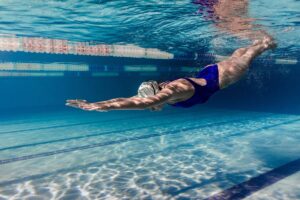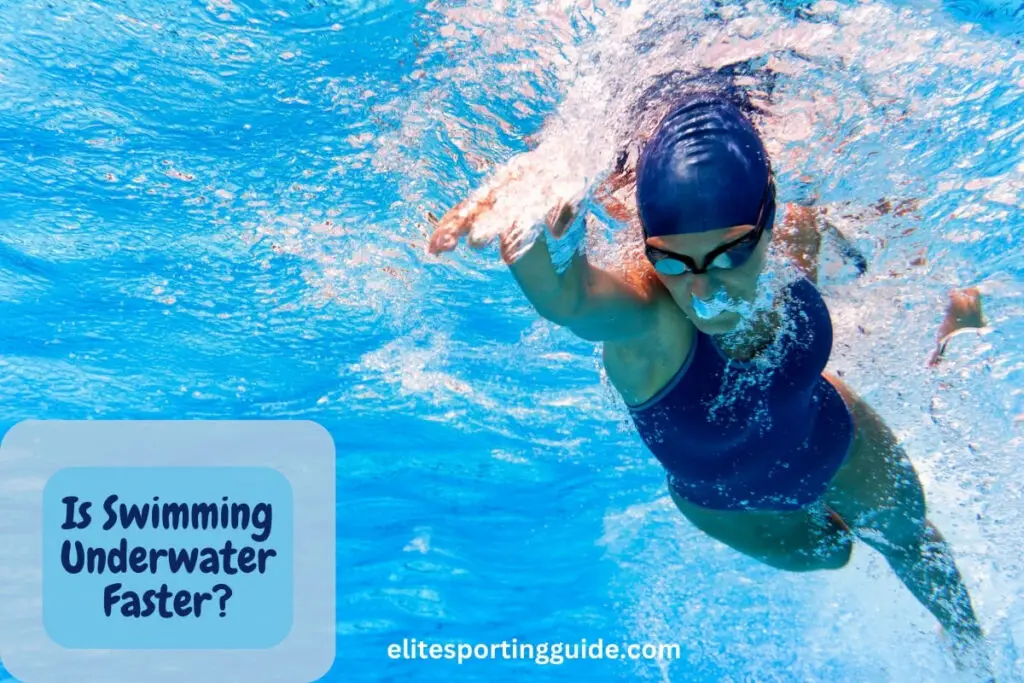From the streamlined movements of aquatic creatures to the techniques utilized by competitive swimmers, we let you know the truth behind the perceived speed boost of underwater swimming.
Is Swimming Underwater Faster?
Yes, swimming underwater can be faster than swimming on the surface due to reduced resistance and drag. In underwater swimming, the body experiences less air resistance and buoyancy, allowing for streamlined movement and potentially greater speed. However, the duration one can sustain underwater swimming is limited by breath-holding capabilities.
The Physics of Underwater Propulsion

The physics of underwater propulsion in swimming is governed by several key principles:
1. Newton’s Laws of Motion: Swimmers propel themselves forward by applying force to the water in the opposite direction they wish to move, according to Newton’s third law of motion, which states that for every action, there is an equal and opposite reaction.
2. Drag and Resistance: As swimmers move through the water, they encounter resistance, or drag, which opposes their forward motion.
Streamlining the body and minimizing surface area reduces drag, allowing swimmers to move more efficiently.
3. Fluid Dynamics: Understanding the behavior of water as a fluid is required for optimizing propulsion. Swimmers manipulate fluid dynamics by creating vortices and eddies with their movements, harnessing these currents to propel themselves forward.
4. Propulsive Forces: Swimmers generate propulsive forces primarily through arm and leg movements, as well as body undulation.
The shape, angle, and timing of these movements determine the magnitude and direction of the propulsive force produced.
5. Hydrodynamic Lift: Similar to lift in aerodynamics, hydrodynamic lift occurs when water flows over the curved surfaces of the swimmer’s body, creating a pressure differential that generates lift, helping to counteract gravitational forces and maintain buoyancy.
6. Efficiency and Technique: Efficient swimming technique minimizes energy expenditure while maximizing forward propulsion. This involves optimizing stroke mechanics, body position, and coordination to minimize drag and resistance.
7. Swim Equipment: Swimmers may utilize specialized equipment such as swimsuits, swim caps, and fins designed to reduce drag, enhance buoyancy, and improve hydrodynamic efficiency, thereby aiding propulsion.
8. Biomechanics: Understanding the biomechanics of swimming movements, including the coordination of muscle groups, joint angles, and body positioning, enables swimmers to optimize propulsion and minimize energy losses.
By applying these principles of physics to their swimming technique, athletes can enhance their efficiency, speed, and overall performance in the water.
Comparing Surface and Underwater Swimming Techniques

Comparing surface and underwater swimming techniques involves:
1. Stroke Efficiency: Stroke efficiency differs notably between surface and underwater swimming due to resistance and propulsion mechanics. Underwater techniques, such as dolphin kicks, often offer higher stroke efficiency because of reduced drag and uninterrupted propulsion, especially during starts and turns. Surface swimming experiences greater resistance from wave drag and requires more frequent strokes to maintain speed.
2. Breathing Patterns: Breathing patterns in surface swimming are regular and integrated into the stroke cycle, allowing swimmers to inhale during specific movements. Underwater swimming restricts breathing entirely, requiring swimmers to hold their breath, which limits duration and affects overall technique and endurance.
3. Body Positioning: In surface swimming, the body must stay near the water’s surface, often causing slight undulation or drag from wave interaction. Underwater swimming allows for a more streamlined, horizontal body position with less drag, enabling smoother and more efficient movement.
4. Kick Technique: In surface swimming, kick technique often involves smaller, quicker movements to maintain balance and propulsion while minimizing surface drag. Underwater swimming, especially during dolphin kicks, uses larger, more fluid, full-body motions that generate powerful propulsion in a streamlined position with minimal resistance.
5. Arm Movement: Arm movements follow a cyclical pattern above and below the water to maximize propulsion and accommodate breathing. However, in underwater swimming, arm movement is typically minimized or used in a single strong pull (as in underwater pullouts), relying more on streamlined gliding and leg propulsion to maintain speed.
6. Turns and Transitions: Turns and transitions in surface swimming involve quickly rotating and pushing off the wall to resume stroke cycles at the surface. However, underwater techniques capitalize on the push-off by maximizing streamlined glides and dolphin kicks before transitioning back to surface swimming, making underwater phases critical for gaining speed and efficiency.
7. Energy Expenditure: Underwater swimming generally requires more energy in short bursts due to the intense effort of holding breath and executing powerful dolphin kicks. Surface swimming spreads energy expenditure over time, allowing for more controlled breathing and pacing, making it more sustainable for longer distances.
8. Practical Considerations: Practical considerations for surface swimming include the need for regular breathing and stroke rhythm, making it suitable for sustained, long-distance swimming. Underwater swimming, while faster over short distances, is limited by breath-holding capacity and competition rules, making it more effective in starts and turns rather than continuous use.
Post you may be interested in: Can Swimming Damage Your Eyes?
Hydrodynamics: Understanding Drag and Resistance
Hydrodynamics is key in understanding drag and resistance in swimming.
1. Drag Forces: The main drag forces in underwater swimming are frictional drag, pressure drag, and wave drag. Frictional drag arises from water rubbing against the swimmer’s skin. Pressure drag results from water resistance against the body’s shape.
Wave drag occurs near the surface due to wave formation. These forces slow the swimmer down by increasing resistance, making streamlined body positioning essential to minimize their impact.
2. Water Turbulence: Water turbulence increases resistance and disrupts smooth water flow around the swimmer, reducing efficiency and speed underwater. Minimizing turbulence through streamlined technique helps maintain optimal propulsion and conserve energy.
Streamlining the Body: How Shape Affects Speed
Streamlining the body is paramount in maximizing swimming speed. This involves:
1. Reducing Frontal Area: Reducing frontal area in underwater swimming decreases water resistance, allowing the swimmer to move more efficiently and maintain higher speeds. A streamlined body position minimizes drag, making each kick or glide more effective
2. Head Positioning: Head positioning in underwater swimming affects speed by influencing body alignment and drag; keeping the head in line with the spine promotes a streamlined posture, reducing resistance. Poor head position can increase drag and disrupt efficient movement, slowing the swimmer down.
3. Body Alignment: Body alignment directly impacts underwater speed by ensuring a streamlined posture that minimizes drag and maximizes propulsion efficiency. Proper alignment allows smooth water flow around the body, enabling faster and more energy-efficient movement.
4. Limbs Positioning: Limb positioning affects underwater speed by maintaining a streamlined shape that reduces drag and enhances propulsion. Properly aligned arms and legs minimize resistance and allow more powerful, efficient kicks and pulls.
5. Role of Swimwear and Equipment: Swimwear and equipment designed for underwater swimming reduce drag and enhance hydrodynamics, helping swimmers move faster with less effort. High-tech suits compress the body and create a smoother surface, while tools like fins can increase propulsion during training.
6. Training for Streamlining: Training for streamlining enhances underwater speed by helping swimmers maintain a compact, aligned body position that minimizes resistance. This allows for more efficient propulsion and longer, faster glides after starts and turns.
Human Physiology in Water
Human physiology in water, particularly regarding breath-holding and buoyancy, significantly influences swimming performance:
1. Breath Holding Techniques: Human physiology affects breath-holding underwater by limiting oxygen availability and causing carbon dioxide buildup, which triggers the urge to breathe. Additionally, the body’s mammalian dive reflex helps conserve oxygen by slowing heart rate and redirecting blood flow, enabling longer breath-hold times but still imposing natural limits on duration.
2. Efficient Breathing Patterns: Human physiology makes efficient underwater breathing patterns challenging because swimmers must coordinate limited breath-holding capacity with oxygen demand and carbon dioxide buildup. The need to optimize oxygen intake quickly during brief surface breaths influences stroke timing and rhythm to maintain endurance and performance.
3. Buoyancy Aids and Equipment: Body composition and lung capacity, influences buoyancy underwater, affecting how swim aids and equipment perform. Buoyancy aids must compensate for natural variations in floatation to help swimmers maintain optimal body position and reduce drag for efficient movement.
4. Physiological Responses to Immersion: The mammalian dive reflex slows heart rate and redirects blood flow to vital organs to conserve oxygen when one is immersed underwater. These adaptations help the body manage oxygen use and maintain stability underwater but also limit how long a person can safely stay submerged.
5. Safety Considerations: Human physiology affects underwater safety by imposing limits on breath-hold time, oxygen supply, and susceptibility to hypoxia or shallow water blackout. Understanding these physiological constraints is necessary to prevent accidents, ensuring swimmers recognize signs of distress and avoid prolonged or unsafe submersion.
Competitive Swimming: Rules and Regulations on Underwater Swimming

Competitive swimming rules and regulations regarding underwater swimming techniques typically include:
1. Starts and Turns: Swimmers are allowed a limited distance underwater after the start and turns, usually up to 15 meters (approximately 49 feet), depending on the stroke and competition rules.
2. Underwater Kicking Phases: Dolphin kicking, a streamlined kicking motion resembling that of a dolphin, is permitted during underwater phases following the start and each turn.
However, there are usually restrictions on the number of dolphin kicks allowed per underwater phase, typically limited to one cycle for breaststroke and butterfly events.
3. Surface Break Requirement: Swimmers must surface and initiate a recognizable stroke cycle after completing the underwater phase. Failure to do so may result in disqualification or time penalties.
4. Distance Limitations: Rules often specify the maximum distance swimmers can cover underwater before surfacing to prevent unfair advantages. This distance is typically regulated for each stroke and event.
5. Officials and Monitoring: Swimming officials, including judges and referees, monitor underwater phases to ensure compliance with rules. Underwater cameras and judges positioned along the poolside may be used to assess swimmers’ adherence to regulations.
6. Penalties and Disqualifications: Swimmers who violate underwater swimming rules may face penalties such as disqualification from the event or time penalties added to their overall race time.
7. Stroke-Specific Regulations: Different strokes may have specific rules governing underwater swimming techniques. For example, breaststroke typically has stricter limitations on underwater phases compared to freestyle or backstroke.
8. Evolution of Rules: Competitive swimming organizations, such as FINA (Fédération Internationale de Natation), periodically review and update rules regarding underwater swimming techniques in response to technological advancements and performance trends, aiming to maintain fairness and integrity in the sport.
Practical Applications: Benefits and Limitations of Underwater Swimming
Practical applications of underwater swimming encompass various benefits and limitations:



